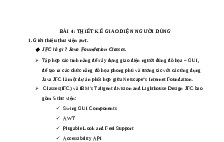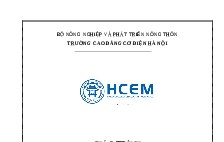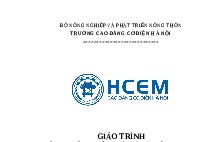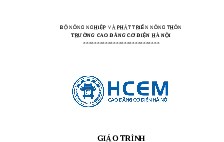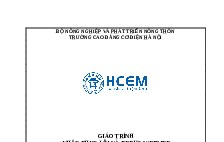SQLServerCh06
Nội dung tài liệu
Tải xuống
Link tài liệu:
Các tài liệu liên quan
Có thể bạn quan tâm
Thông tin tài liệu
Chapter 6
How to code subqueries
Murach's SQL Server 2012, C6
© 2012, Mike Murach & Associates, Inc.
Slide 1
Objectives
Applied
Code SELECT statements that require subqueries.
Code SELECT statements that use common table expressions
(CTEs) to define the subqueries.
Knowledge
Describe the way subqueries can be used in the WHERE,
HAVING, FROM and SELECT clauses of a SELECT statement.
Describe the difference between a correlated subquery and a
noncorrelated subquery.
Describe the use of common table expressions (CTEs).
Murach's SQL Server 2012, C6
© 2012, Mike Murach & Associates, Inc.
Slide 2
Four ways to introduce a subquery
in a SELECT statement
1.
2.
3.
4.
In a WHERE clause as a search condition
In a HAVING clause as a search condition
In the FROM clause as a table specification
In the SELECT clause as a column specification
Murach's SQL Server 2012, C6
© 2012, Mike Murach & Associates, Inc.
Slide 3
A subquery in the WHERE clause
SELECT InvoiceNumber, InvoiceDate, InvoiceTotal
FROM Invoices
WHERE InvoiceTotal >
(SELECT AVG(InvoiceTotal)
FROM Invoices)
ORDER BY InvoiceTotal;
The value returned by the subquery
1879.7413
The result set
(21 rows)
Murach's SQL Server 2012, C6
© 2012, Mike Murach & Associates, Inc.
Slide 4
Where a subquery can be introduced
If a subquery returns…
A single value
It can be introduced…
Anywhere an expression is
allowed
A result set with a single column
In place of a list of values
A result set with one or more columns In place of a table in the FROM
clause
Murach's SQL Server 2012, C6
© 2012, Mike Murach & Associates, Inc.
Slide 5
A query that uses an inner join
SELECT InvoiceNumber, InvoiceDate, InvoiceTotal
FROM Invoices JOIN Vendors
ON Invoices.VendorID = Vendors.VendorID
WHERE VendorState = 'CA'
ORDER BY InvoiceDate;
The result set
(40 rows)
Murach's SQL Server 2012, C6
© 2012, Mike Murach & Associates, Inc.
Slide 6
The same query restated with a subquery
SELECT InvoiceNumber, InvoiceDate, InvoiceTotal
FROM Invoices
WHERE VendorID IN
(SELECT VendorID
FROM Vendors
WHERE VendorState = 'CA')
ORDER BY InvoiceDate;
The same result set
(40 rows)
Murach's SQL Server 2012, C6
© 2012, Mike Murach & Associates, Inc.
Slide 7
Advantages of joins
The result of a join operation can include columns from both
tables.
A join tends to be more intuitive when it uses an existing
relationship between two tables.
A query with a join typically performs faster than the same query
with a subquery.
Advantages of subqueries
A subquery can pass an aggregate value to the outer query.
A subquery tends to be more intuitive when it uses an ad hoc
relationship between two tables.
Long, complex queries can sometimes be easier to code using
subqueries.
Murach's SQL Server 2012, C6
© 2012, Mike Murach & Associates, Inc.
Slide 8
The syntax of a WHERE clause
that uses an IN phrase with a subquery
WHERE test_expression [NOT] IN (subquery)
A query that returns vendors without invoices
SELECT VendorID, VendorName, VendorState
FROM Vendors
WHERE VendorID NOT IN
(SELECT DISTINCT VendorID
FROM Invoices);
Murach's SQL Server 2012, C6
© 2012, Mike Murach & Associates, Inc.
Slide 9
The result of the subquery
(34 rows)
The result set
(88 rows)
Murach's SQL Server 2012, C6
© 2012, Mike Murach & Associates, Inc.
Slide 10
The query restated without a subquery
SELECT Vendors.VendorID, VendorName, VendorState
FROM Vendors LEFT JOIN Invoices
ON Vendors.VendorID = Invoices.VendorID
WHERE Invoices.VendorID IS NULL;
The same result set
(88 rows)
Murach's SQL Server 2012, C6
© 2012, Mike Murach & Associates, Inc.
Slide 11
The syntax of a WHERE clause
that uses a comparison operator
WHERE expression comparison_operator [SOME|ANY|ALL]
(subquery)
A query with a subquery in the WHERE condition
SELECT InvoiceNumber, InvoiceDate, InvoiceTotal,
InvoiceTotal - PaymentTotal - CreditTotal AS BalanceDue
FROM Invoices
WHERE InvoiceTotal - PaymentTotal - CreditTotal > 0
AND InvoiceTotal - PaymentTotal - CreditTotal <
(SELECT AVG(InvoiceTotal - PaymentTotal - CreditTotal)
FROM Invoices
WHERE InvoiceTotal - PaymentTotal - CreditTotal > 0)
ORDER BY InvoiceTotal DESC;
Murach's SQL Server 2012, C6
© 2012, Mike Murach & Associates, Inc.
Slide 12
The value returned by the subquery
2910.9472
The result set
(9 rows)
Murach's SQL Server 2012, C6
© 2012, Mike Murach & Associates, Inc.
Slide 13
How the ALL keyword works
Condition
Equivalent expression
x
x
x
x
x > 2
x < 1
(x = 1) AND (x = 2)
(x 1) AND (x 2)
> ALL (1, 2)
< ALL (1, 2)
= ALL (1, 2)
ALL (1, 2)
Murach's SQL Server 2012, C6
© 2012, Mike Murach & Associates, Inc.
Slide 14
A query that uses the ALL keyword
SELECT VendorName, InvoiceNumber, InvoiceTotal
FROM Invoices JOIN Vendors
ON Invoices.VendorID = Vendors.VendorID
WHERE InvoiceTotal > ALL
(SELECT InvoiceTotal
FROM Invoices
WHERE VendorID = 34)
ORDER BY VendorName;
Murach's SQL Server 2012, C6
© 2012, Mike Murach & Associates, Inc.
Slide 15
The result of the subquery
The result set
(25 rows)
Murach's SQL Server 2012, C6
© 2012, Mike Murach & Associates, Inc.
Slide 16
How the ANY and SOME keywords work
Condition
Equivalent expression
x
x
x
x
x > 1
x < 2
(x = 1) OR (x = 2)
(x 1) OR (x 2)
> ANY (1, 2)
< ANY (1, 2)
= ANY (1, 2)
ANY (1, 2)
Murach's SQL Server 2012, C6
© 2012, Mike Murach & Associates, Inc.
Slide 17
A query that uses the ANY keyword
SELECT VendorName, InvoiceNumber, InvoiceTotal
FROM Vendors JOIN Invoices ON Vendors.VendorID =
Invoices.VendorID
WHERE InvoiceTotal < ANY
(SELECT InvoiceTotal
FROM Invoices
WHERE VendorID = 115);
Murach's SQL Server 2012, C6
© 2012, Mike Murach & Associates, Inc.
Slide 18
The result of the subquery
The result set
(17 rows)
Murach's SQL Server 2012, C6
© 2012, Mike Murach & Associates, Inc.
Slide 19
A query that uses a correlated subquery
SELECT VendorID, InvoiceNumber, InvoiceTotal
FROM Invoices AS Inv_Main
WHERE InvoiceTotal >
(SELECT AVG(InvoiceTotal)
FROM Invoices AS Inv_Sub
WHERE Inv_Sub.VendorID = Inv_Main.VendorID)
ORDER BY VendorID, InvoiceTotal;
The value returned by the subquery for vendor 95
28.5016
The result set
(36 rows)
Murach's SQL Server 2012, C6
© 2012, Mike Murach & Associates, Inc.
Slide 20
Terms
Subquery
Subquery predicate
Correlated subquery
Noncorrelated subquery
Correlation name
Derived table
Murach's SQL Server 2012, C6
© 2012, Mike Murach & Associates, Inc.
Slide 21
The syntax of a subquery with EXISTS
WHERE [NOT] EXISTS (subquery)
A query that returns vendors without invoices
SELECT VendorID, VendorName, VendorState
FROM Vendors
WHERE NOT EXISTS
(SELECT *
FROM Invoices
WHERE Invoices.VendorID = Vendors.VendorID);
The result set
(88 rows)
Murach's SQL Server 2012, C6
© 2012, Mike Murach & Associates, Inc.
Slide 22
A subquery coded in the FROM clause
SELECT Invoices.VendorID, MAX(InvoiceDate) AS LatestInv,
AVG(InvoiceTotal) AS AvgInvoice
FROM Invoices JOIN
(SELECT TOP 5 VendorID, AVG(InvoiceTotal) AS AvgInvoice
FROM Invoices
GROUP BY VendorID
ORDER BY AvgInvoice DESC) AS TopVendor
ON Invoices.VendorID = TopVendor.VendorID
GROUP BY Invoices.VendorID
ORDER BY LatestInv DESC;
Murach's SQL Server 2012, C6
© 2012, Mike Murach & Associates, Inc.
Slide 23
The derived table generated by the subquery
The result set
Murach's SQL Server 2012, C6
© 2012, Mike Murach & Associates, Inc.
Slide 24
A correlated subquery in the SELECT clause
SELECT DISTINCT VendorName,
(SELECT MAX(InvoiceDate) FROM Invoices
WHERE Invoices.VendorID = Vendors.VendorID) AS
LatestInv
FROM Vendors
ORDER BY LatestInv DESC;
The result set
(122 rows)
Murach's SQL Server 2012, C6
© 2012, Mike Murach & Associates, Inc.
Slide 25
The same query restated using a join
SELECT VendorName, MAX(InvoiceDate) AS LatestInv
FROM Vendors LEFT JOIN Invoices ON Vendors.VendorID =
Invoices.VendorID
GROUP BY VendorName
ORDER BY LatestInv DESC;
The same result set
(122 rows)
Murach's SQL Server 2012, C6
© 2012, Mike Murach & Associates, Inc.
Slide 26
A complex query that uses three subqueries
SELECT Summary1.VendorState, Summary1.VendorName,
TopInState.SumOfInvoices
FROM
(SELECT V_Sub.VendorState, V_Sub.VendorName,
SUM(I_Sub.InvoiceTotal) AS SumOfInvoices
FROM Invoices AS I_Sub JOIN Vendors AS V_Sub
ON I_Sub.VendorID = V_Sub.VendorID
GROUP BY V_Sub.VendorState, V_Sub.VendorName)
AS Summary1
Murach's SQL Server 2012, C6
© 2012, Mike Murach & Associates, Inc.
Slide 27
A complex query (continued)
JOIN
(SELECT Summary2.VendorState,
MAX(Summary2.SumOfInvoices) AS SumOfInvoices
FROM
(SELECT V_Sub.VendorState, V_Sub.VendorName,
SUM(I_Sub.InvoiceTotal) AS SumOfInvoices
FROM Invoices AS I_Sub JOIN Vendors AS V_Sub
ON I_Sub.VendorID = V_Sub.VendorID
GROUP BY V_Sub.VendorState, V_Sub.VendorName)
AS Summary2
GROUP BY Summary2.VendorState) AS TopInState
ON Summary1.VendorState = TopInState.VendorState AND
Summary1.SumOfInvoices = TopInState.SumOfInvoices
ORDER BY Summary1.VendorState;
Murach's SQL Server 2012, C6
© 2012, Mike Murach & Associates, Inc.
Slide 28
The result set
(10 rows)
Murach's SQL Server 2012, C6
© 2012, Mike Murach & Associates, Inc.
Slide 29
A procedure for building complex queries
1.
2.
3.
4.
State the problem to be solved by the query in English.
Use pseudocode to outline the query.
If necessary, use pseudocode to outline each subquery.
Code the subqueries and test them to be sure that they return the
correct data.
5. Code and test the final query.
Murach's SQL Server 2012, C6
© 2012, Mike Murach & Associates, Inc.
Slide 30
Pseudocode for the query
SELECT Summary1.VendorState, Summary1.VendorName,
TopInState.SumOfInvoices
FROM (Derived table returning VendorState, VendorName,
SumOfInvoices) AS Summary1
JOIN (Derived table returning VendorState,
MAX(SumOfInvoices)) AS TopInState
ON Summary1.VendorState = TopInState.VendorState AND
Summary1.SumOfInvoices = TopInState.SumOfInvoices
ORDER BY Summary1.VendorState;
Murach's SQL Server 2012, C6
© 2012, Mike Murach & Associates, Inc.
Slide 31
The code for the Summary1 and Summary2
subqueries
SELECT V_Sub.VendorState, V_Sub.VendorName,
SUM(I_Sub.InvoiceTotal) AS SumOfInvoices
FROM Invoices AS I_Sub JOIN Vendors AS V_Sub
ON I_Sub.VendorID = V_Sub.VendorID
GROUP BY V_Sub.VendorState, V_Sub.VendorName;
The result of the Summary1 and Summary2
subqueries
(34 rows)
Murach's SQL Server 2012, C6
© 2012, Mike Murach & Associates, Inc.
Slide 32
Pseudocode for the TopInState subquery
SELECT Summary2.VendorState, MAX(Summary2.SumOfInvoices)
FROM (Derived table returning VendorState, VendorName,
SumOfInvoices)
AS Summary2
GROUP BY Summary2.VendorState;
The result of the TopInState subquery
(10 rows)
Murach's SQL Server 2012, C6
© 2012, Mike Murach & Associates, Inc.
Slide 33
The syntax of a CTE
WITH cte_name1 AS (query_definition1)
[, cte_name2 AS (query_definition2)]
[...]
sql_statement
Murach's SQL Server 2012, C6
© 2012, Mike Murach & Associates, Inc.
Slide 34
Two CTEs and a query that uses them
WITH Summary AS
(
SELECT VendorState, VendorName, SUM(InvoiceTotal)
AS SumOfInvoices
FROM Invoices JOIN Vendors
ON Invoices.VendorID = Vendors.VendorID
GROUP BY VendorState, VendorName
),
TopInState AS
(
SELECT VendorState, MAX(SumOfInvoices) AS SumOfInvoices
FROM Summary
GROUP BY VendorState
)
SELECT Summary.VendorState, Summary.VendorName,
TopInState.SumOfInvoices
FROM Summary JOIN TopInState
ON Summary.VendorState = TopInState.VendorState AND
Summary.SumOfInvoices = TopInState.SumOfInvoices
ORDER BY Summary.VendorState;
Murach's SQL Server 2012, C6
© 2012, Mike Murach & Associates, Inc.
Slide 35
The result set
(10 rows)
Murach's SQL Server 2012, C6
© 2012, Mike Murach & Associates, Inc.
Slide 36
The Employees table
Murach's SQL Server 2012, C6
© 2012, Mike Murach & Associates, Inc.
Slide 37
A recursive CTE that returns hierarchical data
WITH EmployeesCTE AS
(
-- Anchor member
SELECT EmployeeID,
FirstName + ' ' + LastName As EmployeeName,
1 As Rank
FROM Employees
WHERE ManagerID IS NULL
UNION ALL
-- Recursive member
SELECT Employees.EmployeeID,
FirstName + ' ' + LastName,
Rank + 1
FROM Employees JOIN EmployeesCTE
ON Employees.ManagerID = EmployeesCTE.EmployeeID
)
SELECT *
FROM EmployeesCTE
ORDER BY Rank, EmployeeID;
Murach's SQL Server 2012, C6
© 2012, Mike Murach & Associates, Inc.
Slide 38
The final result set
Murach's SQL Server 2012, C6
© 2012, Mike Murach & Associates, Inc.
Slide 39
Terms
Common table expression (CTE)
Recursive query
Recursive CTE
Murach's SQL Server 2012, C6
© 2012, Mike Murach & Associates, Inc.
Slide 40






